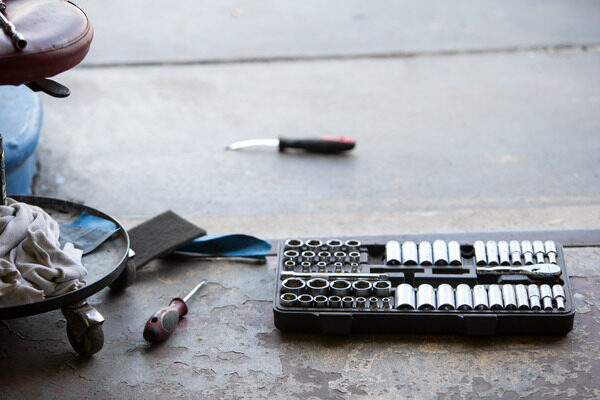
If you’ve ever had a flat tire out on the open road, you know that a car jack can be a driver’s best friend. If you’ve been lucky enough to avoid this misfortune, you might be wondering, what is a car jack?
A car jack is a piece of equipment used to partially lift a car off the ground, usually so that one of its tires can be removed and replaced. Most vehicles come with a car jack included alongside the spare tire since it’s an integral part of the tire changing process.
Types of car jacks
Jacking up your vehicle is not a “one size fits all” operation. Different kinds of jacks are required for different vehicle sizes, and some jacks are preferred simply for their ease of use compared to others.
Most people who have used a car jack have used a scissor jack, a lightweight, portable jack that is operated using a hand crank. The scissor jack’s size and simplicity make it perfect for stowing alongside the spare tire in small to mid-sized vehicles. There are also a couple of different kinds of hydraulic jacks, car jacks that rely on hydraulic systems to lift the car. Trolley jacks, sometimes called floor jacks, are large hydraulic jacks often used by mechanics. Bottle jacks are a smaller variety of hydraulic jacks, often used by truck owners because of their simple design and ability to lift taller, heavier vehicles.
Car jacks also come in different lift capacities, often classified as 2-ton jacks or 3-ton jacks (referring to how much weight they can safely lift).1
There are also pneumatic jacks, which use compressed air to generate the mechanical energy needed to lift a car.2
Car jack safety tips
Jacking up a car is a simple and common procedure that anyone can perform on their own, however, that does not make it any less risky. While that car is lifted, there are thousands of pounds of metal just waiting to fall back to earth. To minimize the chances that your jack will slip, or your car will roll off the jack, it’s always wise to take some safety precautions.
Always make sure that your car is parked before you even consider jacking it up. The jack can apply tremendous upward power, but it won’t be able to do much to stop your car from rolling off. Ideally, you should even use a brick or piece of wood to jam your tire just to ensure it’s not going anywhere. Place the jam under the tire that is at the opposite corner of the one you’re working on. When placing the jack, always make sure it’s positioned directly under the jacking point of your car to ensure it doesn’t lean.3
How to jack up a car
Having a jack and a spare tire in your car won’t do you much good if you don’t know how to jack up a car. You’ll need to know where to put the jack when changing a tire, where the jack points on a car are, and where to jack up the car while you’re out on the road. Fortunately, the process is much more intimidating than it is difficult.
- Start by finding a safe place to pull your vehicle over. You should try to get as far away from traffic as possible.
- Secure your vehicle by putting it in park and blocking off a tire in the opposite corner of the tire you’re working on. That means if you’re changing the front right tire, you want to block the rear left.
- Locate your jack, which is usually under the floor cover of your trunk with the spare tire. Then, find the jacking points on your car. They’re usually located just behind the front wheels and just in front of the rear wheels. If you can’t locate the jacking points, consult your owner’s manual.
- Line up the jack under the jacking point. You may need to spin the jack down to get it low enough.
- Slowly turn the jack handle clockwise until the tire you’re replacing rises off the ground. Always make sure that the jack remains firmly positioned up and down while you do this so it doesn’t lean.
- Once you’ve finished changing the tire, simply turn the crank counterclockwise to lower your car back to the ground. Replace the jack in your trunk, remove the block from your tire, and you’re ready to go.3
If your car breaks down on the highway and the problem isn’t as simple as a flat tire, Nationwide’s roadside assistance program is always there for you. It’s also always a good idea to be insured so that you’re protected no matter what comes your way. Get a free car insurance quote from Nationwide today or explore more auto insurance resources.
1https://rxmechanic.com/types-of-jack/, Accessed November 2021.
2https://www.trenchlesspedia.com/definition/3464/pneumatic-jack, Accessed November 2021.
3https://www.caranddriver.com/features/a27274655/how-to-jack-up-car/, Accessed November 2021.
Disclaimer:
The information included is designed for informational purposes only. It is not legal, tax, financial or any other sort of advice, nor is it a substitute for such advice. The information may not apply to your specific situation. We have tried to make sure the information is accurate, but it could be outdated or even inaccurate in parts. It is the reader’s responsibility to comply with any applicable local, state, or federal regulations. Nationwide Mutual Insurance Company, its affiliates and their employees make no warranties about the information nor guarantee of results, and they assume no liability in connection with the information provided. Nationwide, Nationwide is on your side, and the Nationwide N and Eagle are services marks of Nationwide Mutual Insurance Company. ©2022Nationwide.



